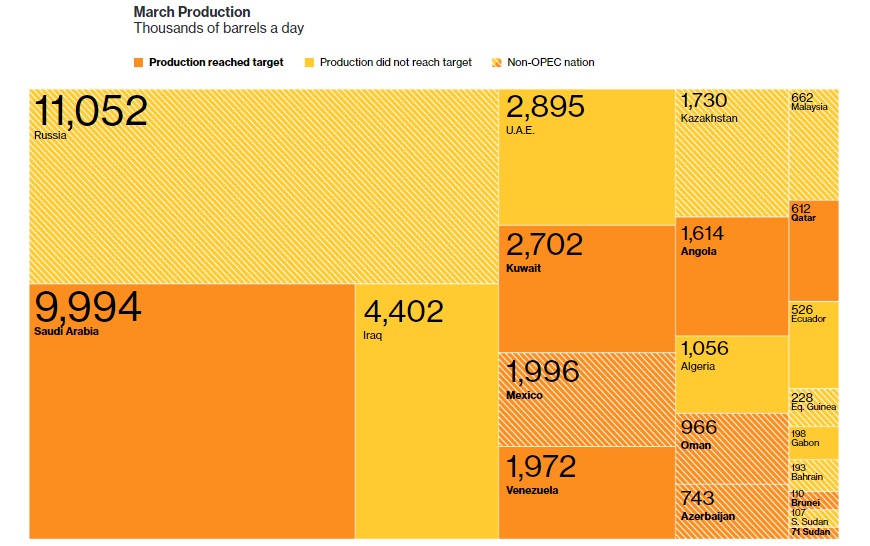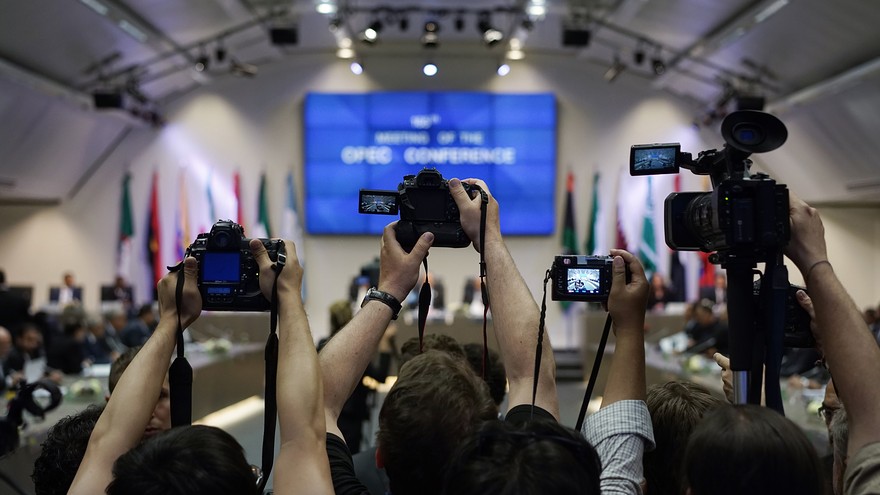Oil producing countries, including those in the Caspian region, are still deliberating whether or not to extend a multilateral agreement reached last year that required cuts to production over the first six months of 2017.
“Consensus is building, but it is not done yet. We are still in consultations,” Saudi Arabia’s energy minister Khalid al-Falih told reporters last week at an energy industry event in Abu Dhabi.
Due to falling oil prices since 2014, in December of last year, the Organization of Petroleum Exporting Countries (OPEC) agreed, along with 12 non-OPEC oil producers, to limit output for six months beginning January 1. Under the terms of the agreement, signatories were to curtail oil supplies by a total of 1.8 million barrels per day (bpd).
OPEC’s 13 member states agreed to cut supplies by a total of 1.2 million bpd, while the non-OPEC countries agreed to cut back by 558,000 bpd. Caspian region non-OPEC countries that agreed to the terms of the deal include Azerbaijan, which agreed to cut back 35,000 bpd; Kazakhstan (20,000 bpd) and Russia (300,000 bpd).
The intent was to reduce a global oversupply of crude in order to lift the price of oil per barrel, and in turn increase revenue for oil-producing countries. In 2014, the price of oil had plunged from $115 per barrel to less than $30 per barrel by 2016. As a result, some countries, such as Kazakhstan and Azerbaijan were forced to devalue their currency, sending shockwaves throughout domestic economies.
While gauging the exact effects of the deal on prices is complex, some argue that the agreement has not done very much to lift global prices and stabilize the market.
Vugar Bayramov, Chairman of the Baku-based think tank Center for Economic and Social Development, told Caspian News that since the beginning of 2017 global crude oil prices have shown an unstable trajectory of ups and downs.
“If crude oil prices for the first three months of 2017 could be considered stable, April saw a decline for both West Texas Intermediate (WTI) and Brent Crude (BC) in global markets,” Bayramov said, referring to two pricing benchmarks. “Today WTI is below $50 per barrel, which is $3 lower than its price in mid-April, while BC fell to $52 from over $56 per barrel in mid-April. Seemingly, the OPEC-led move to drain the oil glut in global markets failed to bring desired results.”
In order for the supply cut agreement to work properly, Bayramov says OPEC needs commitments from non-OPEC oil producers, particularly Russia.
“OPEC will again try to convince Russia to participate in the deal’s extension for three or six months. Russia is of great significance for the oil bloc,” he explained.
Some signatories to the agreement, like Russia and Kazakhstan, have not curbed their output per the terms of the agreement. And while OPEC overall had cut production by more than that is required, only ten of the 21 signatories stayed within their pledged limits. In February, the number of adherents was just five.
“Within OPEC there are clashing ideas over the oil cut policy,” Bayramov told Caspian News. “For instance, Saudi Arabia – the world’s largest oil supplier – believes it may lose its global oil position to the United States in the event of continuous oil cuts. US shale oil is a strong candidate to replace Gulf oil within the global marketplace. Thus, Saudi may agree with prolonging the deal, but behind the scenes it does not want the deal to last long,” he explained.
OPEC is scheduled to convene at its headquarters in Vienna on May 25, to continue discussions about an extension.

Dr. Cyril Widdershoven, Director of the Dutch-based risk consultancy VEROCY, predicted detrimental results for the entire Caspian region if oil prices continue to fall.
“If prices continue to fall, the situation for most countries in the Caspian region will be dire. Not only will overall costs of operations not be met by revenues, but new projects – especially exploration projects in Kazakhstan, Turkmenistan, Iran – will not be feasible to put in place,” Widdershoven told Caspian News. “Both OPEC and non-OPEC countries are seemingly reluctant to adhere to oil cut promises made in January. The main reason is that their economies depend on oil revenues,” he explained.
Baku-based think tank's Vugar Bayramov told Caspian News that sometimes even the current low prices of oil satisfy countries, and they increase their output.
“They don’t want to concede their position in the global oil market, and OPEC lacks a control mechanism to oversee the participant countries’ obedience to their obligations,” Bayramov said.
Russia, the largest non-OPEC signatory, had agreed to cut its output by 300,000 bpd. But by March it was a little more than halfway to that target, cutting only 177,000 bpd. Moscow maintains that it will have reduced production to its pledged amount by the end of this month.
Kazakhstan, whose output reached an all-time high despite it agreeing to cut back, also said it will catch up with its pledged reductions within May and June.
For its part, Azerbaijan announced that it already reduced its oil production even more than promised, and it supports extending the agreement past June 30.







 The number of evacuees from flooded areas in Kazakhstan has reached 97,852 people, including about 32,856 children since March 27.
The number of evacuees from flooded areas in Kazakhstan has reached 97,852 people, including about 32,856 children since March 27.
 The Islamic holy month of fasting, Ramadan comes to an end this week with the celebration of a joyous festival called Eid (meaning “festival” in Ar...
The Islamic holy month of fasting, Ramadan comes to an end this week with the celebration of a joyous festival called Eid (meaning “festival” in Ar...
 Iran's senior military leaders described the drone and missile attack on Israel on April 14 night as “successful".
Iran's senior military leaders described the drone and missile attack on Israel on April 14 night as “successful".
 Azerbaijan officially unveiled the logo for the upcoming 29th session of the Conference of the Parties to the United Nations Framework Convention o...
Azerbaijan officially unveiled the logo for the upcoming 29th session of the Conference of the Parties to the United Nations Framework Convention o...



